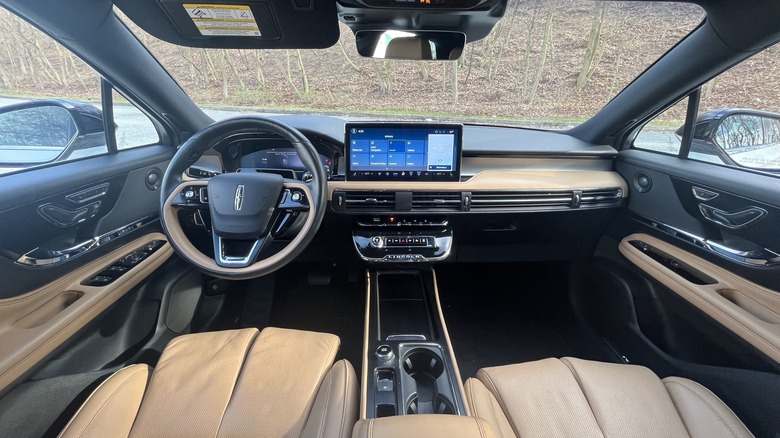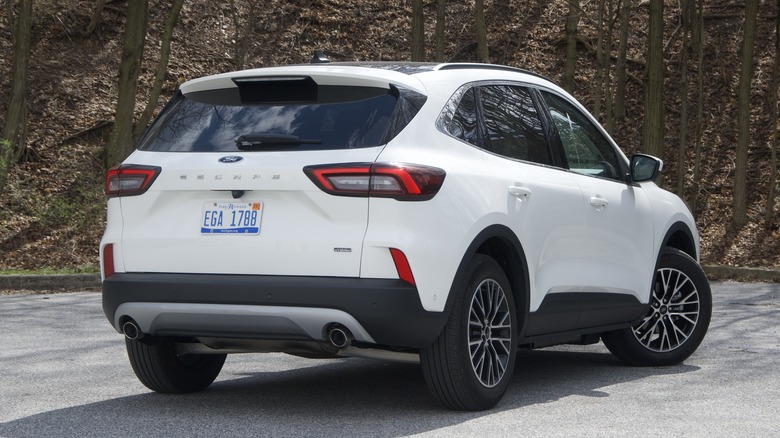Lincoln Corsair Vs Ford Escape PHEV: The Smartest Buy Isn't Always The Most Obvious
While General Motors has been able to keep Cadillac (mostly) separated from its other automotive brands, Ford and its luxury-infused subsidiary Lincoln have been inexorably linked for over a century at this point. While it could be easy to say that Lincolns are just "better" Fords and call it a day, it's a little more nuanced than that. Though a vehicle like the Lincoln Corsair is very nearly mechanically identical to a Ford Escape, the Lincoln treatment more often than not includes a suite of technology that isn't offered on the Ford.
So when I learned that I was going to drive a Ford Escape Plug-In Hybrid and a Lincoln Corsair plug-in hybrid back to back, I concocted a series of road tests to let each respective car stretch their circular legs. Is the Lincoln just a fancy and expensive Ford, or does it offer something unique over its more pedestrian cousin to elevate it? Conversely, is the Ford less than its suit-wearing and cologned counterpart?
The Lincoln Corsair sails in
After a few thousand miles of driving through a number of states, I may have come to a conclusion. But first, let me introduce my humble chariots for the past couple of weeks. First, I drove a 2023 Lincoln Corsair Grand Touring III PHEV. That regal title indicates that it's hosting the "Collection III" options list and is getting a little bit of help from an electric motor.
On a mechanical end, the engine is a 2.5-liter four-cylinder that gives a combined 266 horsepower to its all-wheel drive system. As far as battery specifications and how much help the hybrid drive system gives? Lincoln says "don't worry about it" as exact details are not publicly available on any official Lincoln/Ford sites. According to EPA estimates, it has a 27 mile range before the battery runs dry. That all amounts to about 33 miles per gallon.
The aforementioned Collection III equipment group consists of a head-up display, 14-speaker sound system by Revel, a heated steering wheel, and most importantly, Ford's hands-free driver assistance package, Blue Cruise, here called "ActiveGlide." Optional extras not part of the Collection include 24-way power seats, a "Pristine White" exterior paint color, and 20-inch wheels. "Bells and Whistles" would be an understatement.
The Ford Escape breaks out
The 2023 Ford Escape PHEV was notably different, despite the fact it shares a basic skeleton. The 2.5-liter engine is the same, yet this Escape was not equipped with all-wheel drive. It's not even an option for the PHEV models. As such, the combined power output is 210 horsepower. The Escape is also not equipped with BlueCruise. It was bedecked with what Ford calls the "Plug-In Hybrid Premium Package."
That includes a big light bar across the front fascia that's referred to as the "Coast to Coast" lightbar, quilted leather trimmed seats, a 12.3-inch display branded the "Digital Productivity Screen," 10-speaker Bang & Olufsen sound system, a head-up display, parking and lane assists, and stainless steel trim everywhere. Fuel economy is an estimated 40 miles per gallon and 37 miles in EV mode. It manages to split itself off from the Lincoln in a way that it looks like an entirely separate car.
A trip to New England
When I drove the Lincoln, I figured a longer road trip would adequately test the PHEV's touted fuel economy, the BlueCruise driver assistance feature on well maintained stretches of highway, and most importantly, the luxurious interior. I drove roughly 7 hours to Newton, Massachusetts just outside Boston to visit a friend for an extended weekend. Eventually, we drove to Rockport, Massachusetts to take in the nautical scenery, because where's a better place to experience a Lincoln named after a type of boat than in the company of actual boats? From a comfort and seating perspective, the Lincoln's interior was one of the nicest places I've been in a while.
The piano black and "Cashew" (no longer an option on 2024 model year models) colored leather are "different" from a styling perspective, but it's certainly luxo-barge enough for my tastes. The massaging front seats definitely helped matters, after being stuck in the car for seven hours. After he tuned the 24-way power seats to his liking, my friend–who practically lived in the passenger seat over the course of the trip–fell asleep a number of times. I guess that's a ringing endorsement from his end. From a convenience standpoint, the litany of parking sensors and driving assists made cramped New England city driving a non-issue, thankfully.
Driving efficiently
I had mixed results with using BlueCruise when I drove a Mustang Mach-E earlier in the year, but I am pleased to report that the system on the Lincoln worked swimmingly well. I am not one to drive when I'm fatigued or otherwise not fit to sit behind the wheel, and I genuinely enjoy driving no matter how long the trip, so hands-free systems don't really appeal to me. However, when the Lincoln seamlessly switched to hands-free mode and "took the conn" in nautical/Star Trek terms, I understood what Blue Cruise was for. I was able to mess with the radio, take a drink, and such without careening off the highway, or awkwardly steering with my knee.
From a fuel-efficiency standpoint, the tiny 11.1 gallon fuel tank took getting used to. Still, premium fuel isn't cheap. I achieved around 36 miles per gallon when driving, which I was more than happy with. As the non-Tesla public charging infrastructure around Newton still isn't that robust, I never drove it in pure-EV mode, but I could definitely tell when the electric motor was working or staying out of the equation. It wasn't fast by any means, but 266 horsepower is certainly enough for highway sprints down the Massachusetts turnpike. I never felt like it needed more power.
A cocoon of luxury
I drove the Lincoln for roughly 1,200 miles over the weekend and I never felt like I needed a break from its cocoon of luxury. There were a few slight quibbles I had that are worth mentioning. The headliner just in front of its huge panoramic sunroof rattled incessantly until I rolled up a napkin and wedged it into the space between the headliner and the roof. That could be due to the fact that the Lincoln was technically a very late pre-production vehicle and everything wasn't nailed down as tight, or the blame could lay elsewhere.
More likely to linger as a frustration, the piano black interior surfaces attracted fingerprints and smudges like the world's strongest electromagnet. Lastly, a lot of the seat functions are controlled through a touch screen menu that obscures the entire screen while trying to adjust, which is annoying when you're trying to find out when to make the next turn and the screen insists on telling you how the lumbar support is set.
Normcore at its most efficient
When I got behind the wheel of the Ford Escape PHEV the following week, I was greeted with a much more distinct vehicle, at least in feeling. The interior was much more humble, with less opulent details and a simple black color scheme. Leather was still present, but not as "in your face" as the Lincoln. It might, on the surface, feel like a "worse" car. But it's an almost entirely separate experience altogether. That surprised me.
Instead of BlueCruising around New England in a fancy Lincoln, I drove the Escape in the more sleepy setting of central Pennsylvania. I got groceries, went to the park, drove to the library, and puttered around a church parking lot. Normal Ford Escape stuff. There are few cars that put off a "normal, well adjusted human adult" vibe than a Ford Escape. If it was a file on your computer, it would be CrossoverSUV.jpeg. Not everything needs to be a night out at the opera like the Lincoln Corsair would have you believe. Steely Dan and the Doobie Brothers on the radio are just fine.
Sipping fuel
The lack of all-wheel drive didn't really bother me over the week as the weather was nice, but it was noticed when trying to accelerate. I didn't have both sets of wheels to assist in the feat of forward acceleration. It wasn't pokey when getting on the highway and it never felt unsafe at all, but it sure wasn't anything approaching quick, even when 210 horsepower seems like enough.
If fuel economy was an olympic sport, the Escape would have a decent attempt at a medal. It sipped fuel over the trip, even when I wasn't actively trying. During short drives, the trip computer would often read an estimate of 50 miles per gallon, which is frankly astonishing for a vehicle that isn't a Prius or going 10 miles per hour. Here, the 11.1 gallon tank didn't feel like a limitation.
The inside of the Escape fits firmly into the "fine" category and really isn't anything to write home about. The adjustable seats do their job and the premium sound system is a nice touch. Ford's Sync infotainment system was a source of strife as it decided to update itself a few times and therefore reset settings when I got into the car. I had to unplug and plug my phone into the car a number of times before Apple CarPlay would work. Sometimes it necessitated turning the car off for a minute or two before the infotainment system would figure out what it was supposed to do.
Pricey PHEVs
Boiling the Corsair and Escape down to price paints a little bit of a clearer picture over what vehicle you may actually want to buy. For clarity, prices are for 2024 model years as there are few (if any) differences between the 2023 and 2024 model years. The Lincoln Corsair Grand Touring has a base MSRP of $53,925. For comparison, the non-PHEV Corsair sits at $38,990. Altogether, with the Pristine White paint job, 20-inch wheels, 24-way power seats and Collection III options list, the price totals up to a very Lincoln-like $67,825.
The Escape, strangely, wasn't a lot better considering the car at hand. A bone-stock Escape will set you back $29,495. The privilege of a plug-in hybrid starts at $40,500. The Escape I drove, with its Star White Metallic Tri-coat paint job, panoramic sunroof, and plug-in hybrid premium package, added up to a somewhat startling $49,760. That's a hefty chunk of change for an Escape without all-wheel drive.
A choice to make
Both vehicles are fairly expensive, demanding a minimum of around $50,000 for a PHEV SUV. If price was your number one concern, look elsewhere at perhaps a Toyota Prius Prime, which kicks off at $32,975, or start hunting for a used Toyota RAV4 Prime. However, when you absolutely need a Ford Motor Company product, the Lincoln is a better deal if you want a more luxurious drive with every creature comfort under the sun, and the added benefits of BlueCruise and all-wheel drive. If you need stellar fuel economy and absolutely nothing else, the Escape is your car.
The decision doesn't really need to be much harder than that. Ford has done a thorough enough job of diversifying two mechanically similar vehicles into different use case scenarios entirely, that it really boils down to personal preference and driving habits over any "better" or "worse" metrics. If I was making the choice, I would go with the Lincoln. But I could see going with the Escape if any of my personal likes and dislikes were different.









